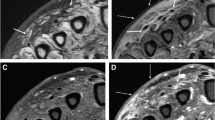Abstract
Background
‘Telangiectatic’ change, which contains a large fluid hemorrhagic component, occurs in a variety of high-grade soft tissue sarcomas.
Methods
In a retrospective database review, we identified 20 consecutive patients (3%) with ‘telangiectatic’ change in soft tissue sarcomas.
Results
Tumors were located in the thigh (55%), shoulder (15%), calf (15%), upper arm (10%), and buttock in one patient. All 20 tumors were high grade. Histological diagnoses were MFH (40%), leiomyosarcoma (15%), synovial sarcoma (10%), and one each of seven other sarcomas (35%). Tumor size was often large—more than 10 cm (35%), between 5 and 10 cm (60%), and less than 5 cm in one case. A history of contusion to the tumor site followed by swelling was recorded in 30% of patients and 80% presented with a painful mass. On MRI imaging, 60% of tumors appeared to contain more than 50% blood, 50% had a hemosiderin-laden rim, and 55% had well-defined tumor nodules within the wall of the hematoma. Limb-sparing surgery was carried out in 90% of patients, the other 10% underwent primary amputation. The 5-year, event-free survival rate was 30%. Of the patients, 15% presented initially with metastatic disease; in 53%, it developed within 2 years of diagnosis. The overall local recurrence rate was 30%.
Conclusions
Telangiectatic transformation in soft tissue sarcomas is a rare feature of aggressive high-grade soft tissue sarcomas and is unique in its clinical presentation, MRI characteristics, pathological pattern, and a tendency for a worse-off prognosis.





Similar content being viewed by others
References
Weiss SW, Enzinger FM. Malignant fibrous histiocytoma: an analysis of 200 cases. Cancer 1978; 41:2250–66
Koea JB, Leung D, Lewis JJ, Brennan MF. Histopathologic type: an independent prognostic factor in primary soft tissue sarcoma of the extremity? Ann Surg Oncol 2003; 10:432–40
Mirra JM, Fain JS, Ward WG, et al. Extraskeletal telangiectatic osteosarcoma. Cancer 1993; 71:3014–9
Matsuno T, Unni KK, McLeod RA, Dahlin DC. Telangiectatic osteogenic sarcoma. Cancer 1976; 38:2538–47
Deyrup AT, Weiss SW. Grading of soft tissue sarcomas: the challenge of providing precise information in an imprecise world. Histopathology 2006; 48:42–50
Greene FLPD, Fleming ID, et al. AJCC cancer staging manual. Springer-Verlag, New-York 2002
Van Dyck P, Vanhoenacker FM, Vogel J, et al. Prevalence, extension and characteristics of fluid-fluid levels in bone and soft tissue tumors. Eur Radiol 2006; 16:2644–51
Aoki T, Nakata H, Watanabe H, et al. The radiological findings in chronic expanding hematoma. Skeletal Radiol 1999; 28:396–401
Guillou L, Coindre JM, Bonichon F, et al. Comparative study of the National Cancer Institute and French Federation of Cancer Centers Sarcoma Group grading systems in a population of 410 adult patients with soft tissue sarcoma. J Clin Oncol 1997; 15:350–62
Bacci G, Mercuri M, Longhi A, et al. Grade of chemotherapy-induced necrosis as a predictor of local and systemic control in 881 patients with non-metastatic osteosarcoma of the extremities treated with neoadjuvant chemotherapy in a single institution. Eur J Cancer 2005; 41:2079–85
Picci P, Bohling T, Bacci G, et al. Chemotherapy-induced tumor necrosis as a prognostic factor in localized Ewing’s sarcoma of the extremities. J Clin Oncol 1997; 15:1553–9
Picci P, Rougraff BT, Bacci G, et al. Prognostic significance of histopathologic response to chemotherapy in nonmetastatic Ewing’s sarcoma of the extremities. J Clin Oncol 1993; 11:1763–9
Picci P, Sangiorgi L, Rougraff BT, et al. Relationship of chemotherapy-induced necrosis and surgical margins to local recurrence in osteosarcoma. J Clin Oncol 1994; 12:2699–705
Raymond AK, Chawla SP, Carrasco CH, et al. Osteosarcoma chemotherapy effect: a prognostic factor. Semin Diagn Pathol 1987; 4:212–36
Alvegard TA, Berg NO, Ranstam J, et al. Prognosis in high-grade soft tissue sarcomas. The Scandinavian Sarcoma Group experience in a randomized adjuvant chemotherapy trial. Acta Orthop Scand 1989; 60:517–21
Eilber FC, Eilber FR, Eckardt J, et al. The impact of chemotherapy on the survival of patients with high-grade primary extremity liposarcoma. Ann Surg 2004; 240:686–97
Grobmyer SR, Maki RG, Demetri GD, et al. Neo-adjuvant chemotherapy for primary high-grade extremity soft tissue sarcoma. Ann Oncol 2004; 15:1667–72
Van Glabbeke M, van Oosterom AT, Oosterhuis JW, et al. Prognostic factors for the outcome of chemotherapy in advanced soft tissue sarcoma: an analysis of 2,185 patients treated with anthracycline-containing first-line regimens—a European Organization for Research and Treatment of Cancer Soft Tissue and Bone Sarcoma Group Study. J Clin Oncol 1999; 17:150–7
Henshaw RM, Priebat DA, Perry DJ, et al. Survival after induction chemotherapy and surgical resection for high-grade soft tissue sarcoma. Is radiation necessary? Ann Surg Oncol 2001; 8:484–95
Author information
Authors and Affiliations
Corresponding author
Additional information
This investigation was performed at the Department of Orthopedic Oncology, Washington Cancer Institute, Washington Hospital Center, Washington DC.
Rights and permissions
About this article
Cite this article
Sternheim, A., Jin, X., Shmookler, B. et al. ‘Telangiectatic’ Transformation in Soft Tissue Sarcomas. A Clinicopathology Analysis of an Aggressive Feature of High-grade Sarcomas. Ann Surg Oncol 15, 345–354 (2008). https://doi.org/10.1245/s10434-007-9637-8
Received:
Accepted:
Published:
Issue Date:
DOI: https://doi.org/10.1245/s10434-007-9637-8




